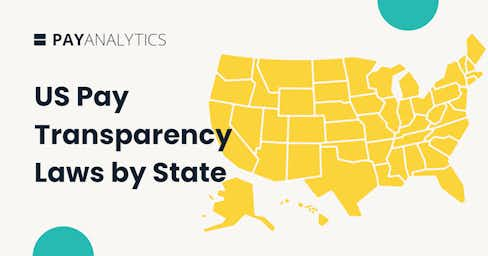A Guide to the EU Pay Transparency Directive 2025 | Download our eGuide for free

US Pay Transparency Laws by State 2025
Last updated: June 30th, 2025.
While there is no comprehensive federal pay transparency law in the United States, pay transparency laws at the state and city level are becoming increasingly prevalent. These regulations require employers to be more transparent with salary ranges and benefits, and they aim to help promote fairness and equity in the workplace.
Our new eGuide on U.S. pay transparency laws by state is now available—download it for free!
Each law is different and handles requirements differently. Depending on the jurisdiction, these laws require employers to:
Disclose salary ranges to applicants at a specified point during the hiring process
Disclose salary ranges to employees upon request
Disclose salary ranges in job postings
Pay transparency has ample benefits. We’ve compiled a list of states and localities that have enacted pay transparency laws. This list also includes details on which employers are impacted and on the specific requirements.
| State | Bill | Requirements | Which employers does it apply to? | Effective date |
|---|---|---|---|---|
|
California |
Must disclose salary range in all job postings, including for jobs that can be done remotely from the state. |
Employers with 15 or more employees, with at least 1 working in California. |
January 1, 2023 |
|
|
Must disclose position’s salary range to current employees upon request. |
Employers with 1 or more employees. |
|||

Learn more about pay transparency regulations in California |
||||
|
Colorado |
Equal Pay for Equal Work Act |
Must disclose in all job postings, including for jobs that can be done remotely from the state:
|
Employers with at least 1 employee working in Colorado. |
January 1, 2021 |

Learn more about pay transparency regulations in Colorado |
||||
|
Connecticut |
Must provide wage range information to an applicant upon the earliest of:
Must provide an employee the wage range for the employee’s position upon:
|
Employers with at least 1 employee working in Connecticut. |
October 1, 2021 |
|

Learn more about pay transparency regulations in Connecticut |
||||
|
District of Columbia |
Job postings (including internal announcements) must include salary range or hourly pay rate (minimum/maximum). Employers must give candidates healthcare benefits information before the first interview. Employers cannot ask job candidates about salary history and cannot retaliate against employees who discuss compensation. |
Any employer with at least one employee in Washington, D.C. |
June 30, 2024 |
|
|
Hawaii |
Hawaii Pay Transparency Law |
Must disclose salary ranges and hourly rates in external job listings that must “reasonably reflect” actual expected compensation. Equal pay for substantially similar work through the prohibited of discriminate between employees because of any protected category. |
Employers with 50 or more employees. |
January 1, 2024 |

Learn more about pay transparency regulations in Hawaii |
||||
|
Illinois |
Illinois Pay Transparency Law |
Must include pay scale and benefits in all job postings. This includes work performed outside of Illinois if the employee will report to an Illinois-based office. Promotion opportunities must be announced/posted to current employees within 2 weeks of posting the job externally. |
Employers with 15 or more employees. |
January 1, 2025 |

Learn more about pay transparency regulations in Illinois |
||||
|
Maryland |
Equal Pay for Equal Work Law |
Wage range must be included in internal and external job postings, along with information about benefits and other compensation. Employer cannot discriminate against job candidates or candidates for promotion who do not disclose wage history. |
Any employer engaged in business in the state of Maryland. |
October 1, 2024 |

Learn more about pay transparency regulations in Maryland |
||||
|
Massachusetts |
Frances Perkins Workplace Equity Act |
All job postings and promotion/transfer offers must include a pay scale (salary or hourly wage range). |
Employers with 25 or more employees. |
July 31, 2025 |
|
Minnesota |
Job postings must include starting salary range (minimum and maximum) or fixed pay rate. Ranges must be a “good faith estimate” and not open-ended. Postings must also include benefits (including health and retirement) and all other compensation. |
Employers with 30 or more employees |
January 1, 2025 |
|
|
Missouri (Kansas City) |
Cannot ask job candidates about salary history, cannot use past pay to screen or to determine compensation, and cannot refuse to hire an employee who opts not to disclose. |
Employers with 6 or more employees. |
October 31, 2019 |
|
|
Nevada |
Must provide applicants who have completed an interview for a position the wage or salary range or rate for the position. Must provide the wage or salary range or rate for a promotion or transfer to a new position if an employee has:
|
Any employer in Nevada. |
October 1, 2021 |
|

Learn more about pay transparency regulations in Nevada |
||||
|
New Jersey |
New Jersey Pay and Benefit Transparency Act (formerly Bill S2310) |
Current employees in relevant departments must be made aware of job openings before a promotion decision is made. All job listings must include specific pay rates or ranges and list other benefits and compensation. |
Employers with 10 or more employees over 20 calendar weeks that does business in or employs people in New Jersey. |
June 1, 2025 |

Learn more about New Jersey's statewide pay transparency legislation |
||||
|
New Jersey (Jersey City) |
Must provide the salary range and description of benefits in all ads for any job, transfer or promotion opportunity. |
Employers with five or more employees within Jersey City. |
April 13, 2022 |
|

Learn more about pay transparency regulations in Jersey City |
||||
|
New York |
Must disclose the compensation or a range of compensation in any advertisement for a job, promotion, or transfer opportunity. Must also provide the job description for such job, promotion, or transfer opportunity, if such a description exists. |
Employers with 4 or more employees. |
September 17, 2023 |
|
|
New York (New York City) |
Must disclose a minimum and maximum annual salary or hourly wage in any advertisement for a job role that will or may be filled in New York City, including for jobs that can be done in the field or remotely from the city. Must disclose a minimum and maximum salary range in any posting for internal promotions or transfer opportunities. |
Employers with 4 or more employees, with at least one in New York City. |
November 1, 2022 |
|

Learn more about pay transparency regulations in New York City |
||||
|
New York (Ithaca) |
Must disclose minimum and maximum hourly or salary compensation in any postings for a job, promotion, or transfer opportunity. |
Employers with 4 or more employees. |
September 1, 2022 |
|
|
New York (Westchester County) |
Must disclose minimum and maximum salary range on all job ads for roles that will or may be filled in Westchester, including for jobs that can be done remotely from the county. Must disclose the minimum and maximum salary in any posting for promotion or transfer opportunity . |
Employers with 4 or more employees. |
November 6, 2022 |
|
|
Ohio (Cincinnati) |
|
Must provide a salary range upon a candidate’s request after conditional offer of employment is made. |
Employers with more than 15 employees in Cincinnati. |
March 13, 2020 |
|
Ohio (Cleveland) |
|
Employers must provide pay ranges in job postings. Employers cannot ask job candidates about salary history, cannot use past pay to screen or to determine compensation, and cannot refuse to hire an applicant for not disclosing salary history. |
Employers with 15 or more employees in Cleveland. |
October 27, 2025 |
|
Ohio (Columbus) |
Employers may not ask job applicants about pay history, use public records to obtain that information, use past pay to determine compensation, or retaliate against applicants who do not disclose. |
Employers with 15 or more workers in Columbus. |
March 1, 2024 |
|
|
Ohio (Toledo) |
Must provide a salary range upon a candidate’s request after conditional offer of employment is made. |
Employers with 15 or more workers in Toledo. |
June 25, 2020 |
|
|
Rhode Island |
Must disclose:
|
Rhode Island employers with 1 or more employees in the state. |
January 1, 2023 |
|
|
Vermont |
Job postings must include minimum and maximum good faith estimate for the salary range or wage range. |
Employers with at least 5 employees overall and at least 1 working in Vermont. |
July 1, 2025 |
|
|
Washington |
Equal Pay and Opportunities Act |
Must disclose:
Amendment in 2025 (SSB 5408) gives employers who receive notice of a non-compliant job listing a cure period of 5 business days to fix it; allows listing one fixed amount instead of a pay range; and clarifies remedies for affected job applicants. |
Employers with 15 or more employees, if they have one or more Washington-based employees or if they engage in business in Washington or recruit for jobs that could be filled by a Washington-based employee, including remote jobs. |
January 1, 2023 |

Learn more about pay transparency regulations in Washington |
How can PayAnalytics help employers meet pay transparency requirements in various states, cities, and counties?
PayAnalytics is a global solution adaptable to all primary regulatory environments. With our universal, scientifically driven pay equity tool, US employers can easily:
- Analyze data and measure and monitor pay gaps by any demographic variable.
- Look for and analyze outliers (individual employees whose pay shows a significant discrepancy compared to their peers’ pay).
- Correct pay discrepancies and close pay gaps by making the appropriate changes suggested by the software and understanding the associated costs.
- Analyze salary structure to allow more transparency with employees, making it easier to talk with them about why they’re being paid what they’re paid.
- Prevent pay disparities and sustain fair pay with ongoing decision support.
- Report and share pay equity information with a user-friendly, flexible reporting feature. Do not hesitate to contact us for further inquiries or to book a software demo. You can find more information about PayAnalytics software features here.
The information on this page is not intended to serve and does not serve as legal advice. All of the content, information, and material in this article are only for general informational use. Readers are advised that this information, legal or otherwise, may not be up-to-date.





